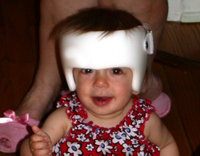Bu[ddot{u}]lent Mamikoglu
Ayseg[ddot{u}]l Mamikoglu
Abstract
Crouzon's syndrome is a hereditary autosomal-dominant disorder. In its classic form, patients experience a premature closure of the cranial sutures, which leads to brachycephaly, proptosis, a small maxilla, and anomalies of the external and middle ear. In this report, we describe the case of a father and son who both had a nonsevere form of this disorder. The two men did not have brachycephaly or proptosis, but they did have ptosis and a mixed-type hearing loss.
Introduction
Crouzon's syndrome is a hereditary autosomal-dominant form of the craniofacial dysostosis disorders. Approximately one-third of all cases of craniofacial dysostosis occur in patients who do not have a familial predisposition to it. Crouzon's syndrome is characterized by premature craniosynostosis, brachycephaly, shallow orbits, and a hypoplastic maxilla. No single skull shape is diagnostic of craniofacial dysostosis, because the eventual shape of the head depends on the sequence in which the skull sutures fused. [1] For example, the bilateral fusion of coronal and lambdoid sutures results in turricephaly (tower skull) and markedly increases intracranial pressure and restricts brain growth. [2]
This article describes two cases of nonsevere craniofacial dysostosis in a father and son, which were characterized by mesocephaly and ptosis.
Case report
A 19-year-old man was admitted to our otolaryngology outpatient department for an evaluation of hearing loss. He had an atypical facial appearance, with a short nose, ptosis, and mesocephaly (figure 1). The auricle was slightly large, but the eardrum was barely visible because of stenosis of the external ear canal. The external canal appeared to be compressed from the anterior to the posterior.
A bilateral Rinne's s test was negative, and a Weber's test did not lateralize. A pure-tone audiologic test revealed an average bilateral mixed-type 45-dB hearing loss. His sagittal suture was palpable, but the coronal suture was not. The man was otherwise healthy and had a normal intellect. His mother and father were not blood relatives.
We asked the patient's father to come in for an examination. The father suffered from extreme ptosis and a mixed-type hearing loss. His auricle was macrotic, and his external ear canal was extremely stenotic, which nearly blocked the view of the eardrum. He also had a short nose with anteverted nares, a palpable sagittal suture, and a dolichocephalic skull shape (figure 2).
Discussion
According to Wullstein and Wullstein, the growth of the skull takes place in three phases. [3] During the first phase, from birth to the second year of life, synchondrosis is responsible for skull growth. The hyaline cartilage of the temporomandibular joint is responsible for the second phase of growth, which occurs between the ages of 2 and 7 years. In the third phase, from age 7 to adulthood, growth takes place primarily in the central part of the face. The premature ossification of a synchondrodial joint at the skull base will change the shape of the skull and will inhibit growth in the central part of the face and the temporal bone.
Patients with Crouzon's syndrome usually have a normal intellect. In its most severe form, the syndrome is characterized by turricephaly, an increase in intracranial pressure, and mental retardation. Crouzon's syndrome is associated with chronic otitis media and anomalies of the middle ear, including the absence of the tympanic membrane, ankylosis of the malleus, deformity of the stapes with narrowing of the middle ear space, and underdevelopment of the periosteal portions of the labyrinth. Corrective surgery is extensive.
From the Validebag Teachers Hospital, Kosuyolu, Istanbul, Turkey (Dr. B. Mamikoglu), and the Haydarpasa Central Hospital, Haydarpasa, Istanbul (Dr. A. Mamikoglu).
Reprint requests: B[ddot{u}]lent Mamikoglu MD, Nuhkuyusu Cad No: 18\6, [ddot{U}]sk[ddot{u}]dar 81150, Istanbul, Turkey. Phone: 90-312-235-0220; fax: 90-312-441-4674; e-mail: bulentmamikoglu@hotmail.com
References
(1.) Bertelson TI. The premature synostosis of the cranial sutures. Acta Oplithalmol Suppl 1958;51:1-6.
(2.) Marentette L.J. Craniofacial surgery for congenital and acquired deformities. In: Cummings CW, Krause CJ, eds. Otolaryngology-Head and Neck Surgery. Vol. 1, 2nd ed. St. Louis: Mosby-Year Book, 1993:347-52.
(3.) Wullstein HL, Wullstein SR. Tympanoplasty: Osteoplastic Epitympanotomy. Stuttgart: George Thieme Verlag, 1990.
COPYRIGHT 2000 Medquest Communications, Inc.
COPYRIGHT 2000 Gale Group



